News
23.03.2002 FIAT PALIO
REACHES CHINA
- The World Car project has now reached
China, the Palio will be built and marketed in China in a joint venture
with the Yuejin Motor Group, the first models due to roll off the producion
line shortly after Easter.
overview
the
World Car Project
the
Fiat Group in China
the
Fiat Palio
see
the Palio
overview
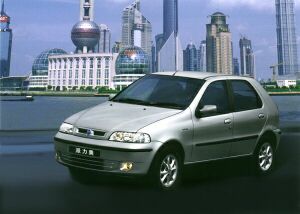 In
the first quarter of 2002, Nanjing Fiat, the 50-50 joint venture set up
by the Fiat Group and the Yuejin Motor Group, begins to market and sell
the Fiat Palio in China. It is an important new step in the fruitful collaboration
that has linked the two companies for many years in the fields of commercial
vehicles (Iveco) and components (Teksid). The launch of the Palio today
opens up new horizons in what experts consider a rapidly expanding car
market. Suffice it to say that China's entry into the WTO and the 10th
five-year plan approved by the Chinese government envisage a significant
increase in sales in the next 3-4 years, from today's 700,000 units to
over 1.2 million cars.
In
the first quarter of 2002, Nanjing Fiat, the 50-50 joint venture set up
by the Fiat Group and the Yuejin Motor Group, begins to market and sell
the Fiat Palio in China. It is an important new step in the fruitful collaboration
that has linked the two companies for many years in the fields of commercial
vehicles (Iveco) and components (Teksid). The launch of the Palio today
opens up new horizons in what experts consider a rapidly expanding car
market. Suffice it to say that China's entry into the WTO and the 10th
five-year plan approved by the Chinese government envisage a significant
increase in sales in the next 3-4 years, from today's 700,000 units to
over 1.2 million cars.
The Fiat Palio now enters
this market, the first step in a long-term development project. Its presence
on the Chinese market represents a strategic initiative for the Group,
borne out by the investments undertaken so far. And we cannot overlook
the fact that the products built by Fiat in Nanking will become a benchmark
for the world and it will be the local suppliers who benefit most. In other
words, it is a great opportunity for the country where competitiveness
and technology are growing rapidly. And the social transformation underway
seems to be equally rapid. The Fiat Palio addresses the many young Chinese
families who will buy it as their first car, the realisation of their dreams,
and a clear sign of an improvement in their daily lives. But the model
is also destined for single customers, lovers of beauty and Italian design,
who are interested in the equipment and running costs. Customers, in both
cases, who want the best and will not accept compromise. And to satisfy
them, Fiat Auto decided a long time ago to work with the best Chinese distribution
experts, so as to guarantee impeccable service.
The
World Car Project
The '178 Project', which
produced the Palio, was begun when Fiat Auto decided to develop a 'world'
car to meet the company's need for greater manufacturing capacity in emerging
countries such as South America, Africa, Centre and East Europe, and Asia.
Different markets, with different
cultures and needs, which are difficult to meet with a single model. As
a result, it was decided to develop not one car but a modular platform
with several bodywork types. Different models developed from a single matrix,
which adopted the most advanced quality standards to ensure that the models
would be competitive on every market in terms of styling, safety, technology,
price and reliability.
And so the Fiat Palio was
born, the Fiat Group's first 'world car'. It was presented in April 1996
at Ouro Preto (Brazil), and the forefather of this family of cars was gradually
joined by the other models (the Siena, Palio Weekend and Strada) all with
an international spirit, which in six years have decreed the great worldwide
success of the '178 project'. This is borne out by the fact that today
the four models are marketed in forty countries, produced in nine plants,
distributed in four continents and that over two million units have been
sold.
The sales volumes and market
share are therefore worthy of note, rewarding the globalisation strategy
that Fiat Auto has pursued in recent years, in which the Palio represents
the first step of a vast programme addressing a number of countries where
motorisation is expanding fast. And now the first member of the 178 family
reaches China, sustained by the market success that has enabled the Palio,
the 2-box model of the World Car, to reach total sales of 1.3 million units
the world over in six years.
The 178 family also makes
the Fiat range extremely versatile, able to exploit all sales opportunities.
In some countries only a single model is produced and marketed, while all
versions are available in others. In other words a differentiated response
from a single project, that reflects the needs and characteristics of each
market. Nor can we forget that this worldwide initiative has given rise
to a vast number of agreements with the main international suppliers, and
the commitment to stimulate the exchange of components and to encourage
the growth of local industry.
At this point it is clear
that such a broad, complex project could not be implemented in a conventional
way. This is confirmed by the fact that Fiat's first 'world car' was also
developed on a global scale, through a process that marked a new departure
in the company's history. A multinational team of experts from different
countries, defined the features of the model, bearing in mind the specific
demands of each of the markets in which the Palio would be sold. What is
more, the 60 major components suppliers to the Palio were involved in the
development of the product as 'co-designers'. They guaranteed strictly
identical components, built in all parts of the world with the same materials,
the same manufacturing processes, the same technologies and the same quality.
This strategy made it possible
to cut development time for the model, but above all to guarantee that
the manufacturing standards, and therefore the quality of the Palio - and
now of the Siena, Palio Weekend and Strada - are always the same and the
highest possible, wherever the car is built and whatever the labour culture
and mentality of the country in which it is manufactured.
Joint development also made
it possible to harmonise the technological and manufacturing processes
of the models in the 178 family rapidly throughout the world, a key factor
for the achievement of a series of savings that guarantee that the end
product has a competitive cost. To achieve this result, the specific expertise
of each Fiat plant in the world was evaluated, and production of parts
and components for the cars was assigned to one plant or another according
to the specific skills of each one.
The Fiat Group in
China
The Fiat Group operates in
the People's Republic of China through 7 representative offices, 9 joint
ventures and 5 wholly-owned enterprises.
The industrial presence in
China of sectors of the Fiat Group extends from Fiat Auto (cars) to Iveco
(commercial vehicles and buses), CNH - Case New Holland (agricultural tractors
and equipment), Magneti Marelli (components), Teksid (foundries) and Comau
(automation for the automotive industry).
The Fiat International Representative
Office in Beijing represents all the Fiat Group companies in China. In
2001, the aggregate revenues of its joint ventures and wholly-owned companies
in China amounted to more than $400 million. The workforce exceeds 10,000.
Total investments already undertaken or planned in China by Fiat Group
subsidiaries and their partners amount to over $1 billion.
History:
Fiat was established in Turin,
Italy, in 1899. A few years after its foundation, the company started to
export cars to China. Industrial activities were begun in China in 1986
alongside marketing enterprises. Iveco, the industrial and commercial vehicles
manufacturer, signed a contract with China's Yuejin Group covering the
transfer of technology transfer and technical services related to production
of the Daily light commercial vehicle in China. In 1996, Naveco, a 50-50
joint-venture company, was set up. A few months later, Iveco and Yuejin
Group founded a second 50-50 joint-venture, Haveco, to produce gearboxes.
In the mid 1990s, the Fiat Group's industrial presence in China expanded
further. Magneti Marelli and Teksid started operations in the fields of
automotive components and foundries respectively. Fiat Auto and CNH-Case
New Holland launched ventures in the areas of cars and agricultural tractors
and equipment respectively.
Fiat Group sectors operating
in China:
Fiat Auto SPA
Nanjing Fiat is a joint venture
between Fiat Auto of Italy and the Yuejin Motor Group. Its total assets
amount to 2.5 billion RMB, with each partner accounting for 50% of the
share capital. It is located in the Industrial New Technology Park of Jiangning
District, Nanjing, with a surface area of 640,000 square metres and a covered
area of 270,000 square metres.
To prepare for the
birth of the Palio in Fiat's Chinese plant, the joint venture has purchased
important equipment from all over the world to assure its quality. There
are currently 4 large combined workshops with ancillary power and support
systems. The Engine plant and the Gearbox plant have 10 and 24 automatic
production lines imported from abroad respectively. In the Assembly plant,
there are 2 handspike and suspended hinged assembly lines with 248 whole-car
workstations, including a visual adjustment system, a rain-effect test
track and an inspection line that meets the most advanced international
standards. All the key equipment was imported from abroad. In the Bodywork
and Welding plant, there is a pressing line made up of a series of twin-feed
2000-tonne presses and four series of single-feed 1000-tonne mechanical
presses for large sheet metal parts. This line is the biggest of its type
in China and most of the dies are designed and built by Fuji of Japan.
On the welding line, there are 422 imported standard welding machines,
and 7 bodywork and components assembly lines. The general welding lines
and main equipment were imported from South Korea. The painting plant adopts
the most advanced techniques, designed and manufactured by Haden (U.K.).
More than 30 foreign technicians have worked for the joint venture, and
co-operated actively with their Chinese colleagues in the field of key
technologies and line management, linking the activities of the plant with
those of Fiat's global facilities.
Iveco
In 1996, Iveco and the Yuejin
Group founded the Nanjing Iveco company, a 50-50 joint-venture for the
production and marketing of the DAILY light commercial vehicle.
In July 1996, Haveco Automotive
Transmission Co. Ltd, a 50-50 joint-venture to manufacture gearboxes, was
set up by Iveco and Yuejin.
In May 2001, Iveco and the
Changzhou Bus Company founded a 50-50 joint venture to manufacture and
sell buses.
CNH - Case New Holland
In 1999, New Holland and
a subsidiary of the Heilongjiang State Farm established a joint venture,
Harbin-New Holland Beidahuang Tractors Co. Ltd., to produce agricultural
tractors.
CNH and the Shanghai Tractors
& Internal Combustion Engines Company (a SAIC Group subsidiary) signed
an agreement which covers the development and manufacture of small tractors,
combines, and forage harvesting equipment.
Case has also established
a Chinese joint venture, Case Machinery Co. Ltd (Shanghai), in the Waigaoqiao
Free Trade Zone of Shanghai, to import and market agricultural equipment.
TEKSID Company
Teksid, the metallurgical
products sector of the Fiat Group, operates in China through a number of
joint ventures.
The Nanjing Teksid Iron Foundry
and Hua Dong Teksid Automotive Foundry are active in the field of cast
iron, while the Nanjing Teksid Aluminium Foundry produces cast aluminium
components for the automotive industry.
MAGNETI MARELLI Company
Magneti Marelli, the automotive
components sector of the Fiat Group, is present in China with the following
wholly-owned enterprises:
the Magneti Marelli Guangzhou
Motor Vehicle Instruments Company, which produces instruments, sensors
and electronic modules for motor vehicles.
the Magneti Marelli Automobile
Spare Parts Company, producing throttle bodies.
the Magneti Marelli Shanghai
Powertrain Company, which produces engine control systems and power devices.
COMAU
Comau, the Fiat Group automation
and production systems sector, furnishes major automotive manufacturers
in China with its advanced products.
FiatAvio
FiatAvio, the Fiat Group's
aviation and space Sector, is actively involved in the maintenance of civil
aircraft engines in China.
The Fiat Palio model
Fiat Palio is not merely
a new model, but also the first model of a new generation of cars to be
built in China.
In fact it is the first new
compact hatchback that offers features that until now were only offered
by higher segment cars, such as safety, comfort and high equipment levels.
The Fiat Palio represents
the best synthesis of the values that have won the Fiat brand renown all
over the world:
Unique Style and design
Driveability
Low fuel consumption
Low running costs
And, above all, high quality
that means quality components, accurate assembly and product reliability.
The Fiat Palio is a successful
model all over the world: in just four years, more than 2 million customers
in 40 different markets - including Germany, Italy, France, Spain, Brazil,
Argentina, Turkey and India - have purchased one of the many versions of
the Palio, which is manufactured in nine countries and exported to another
31.
The Palio to be manufactured
in China is the last generation of the series. It was originally launched
on the Brazilian market and has won the Car of the Year award. It will
be launched in Europe in May.
Styling and interior
The project by Giorgio Giugiaro,
named car designer of the century, reveals typically Italian styling, modernity
and an exclusive personality.
The design reflects the designer's
intention of creating a car that could adapt to different cultures and
environments, and would be appreciated by customers from different countries.
In a word, it is a real world citizen.
Fluid curves and a sloping
windscreen make for a comfortable interior. The bumpers are solid and reassuring.
The front part of the car
looks modern, stable and spacious. The light clusters have transparent
covers and the non-abrasive halogen headlights have multiple reflectors.
The interiors blend harmoniously
with the exterior styling and ensure category-beating comfort, space, ergonomics
and safety.
Nothing has been left to
chance in the passenger compartment: colours, material textures (the range-topping
version features elegant leather upholstery), visual and tactile impressions
and space have been carefully chosen. The interior design focuses on the
rational use of space in a good combination of ergonomics and practicality.
The space around the front and rear seats is perfectly exploited. The luggage
compartment is also of a generous size.
Safety
The Fiat Palio was responsible
for introducing new safety standards that had previously not been adopted
on cars of its segment, because it is built to stringent international
safety legislation.
The Palio is the benchmark
in China for customers seeking a car that offers the best, state-of-the-art
devices to prevent accidents (active safety) and to minimise their consequences
(passive safety).
Passive safety
Airbags. The car is fitted
with the newest generation airbag, with a 'smokeless' mechanism. The driver's
45 litre bag offers greater protection. The passenger airbag can be deactivated
when the seat beside the driver is unoccupied. This prevents the airbag
from deploying unnecessarily if the car crashes. To deactivate the airbag,
simply insert the ignition key into a lock near the handbrake lever and
turn.
Programmed crumple-zones.
The front and rear parts of the car have been designed to crumple gradually
during impact and thus absorb kinetic energy that would otherwise be transmitted
to the passenger compartment.
Survival cell. The passenger
compartment, on the other hand, has been greatly reinforced. In effect
it is a survival cell that safeguards the occupants against harm.
Side impact bars. New side
impact bars in the doors are secured to a reinforced central column and
bolster the car against side impact.
Steering. The steering wheel
has also been designed to absorb impact energy and the steering column
is designed to crumple. Both devices are built to ensure they do not harm
the driver if the car crashes.
Seat-belts with load limiter.
In addition to a pretensioner, the seat-belts also come with a device that
limits the pressure exerted on passengers' chests. The limiter also increases
the belt's damping efficiency.
Fire Prevention System, FPS.
This consists of several components including an all-important inertia
switch that shuts off the fuel flow in a collision. Interior materials
with low flame propagation properties also limit potential fire damage.
Performance and control =
active safety
Performance and control are
the result of numerous devices and technologies, including effective, stable
brakes, acceleration, and control of the vehicle on all types of road.
The suspension of the Fiat
Palio gives the car great stability and excellent handling to ensure that
the driver has full control of the car at all times, reducing bumps, nose
levels and vibration.
Braking system with cross-over
circuit: if one branch fails, the other ensures system efficiency.
ABS + EBD (Electronic Brake
effort Distribution). During emergency stops, the system prevents the brakes
from locking and allows more accurate correction of the braking pressure
on the rear axle. This means that braking force is more effectively distributed
and stopping distances are reduced under all load conditions.
High torsional rigidity increases
the sturdiness of the car body, ensuring greater stability.
Comfort = preventive safety
To guarantee the highest
level of passenger comfort, all the components of a car need to be designed
to create an interior environment that enhances driving enjoyment and control
of the car, enabling the driver to maintain his concentration even on long
journeys.
The various aspects of comfort
of the interior environment influence preventive safety.
For the Fiat Palio, this
includes the climate system, the position of the controls, the comfort
of the environment, quiet running (low noise level of the running wheels,
the efficiency of the suspension system, friction material, wind noise,
abnormal sound of the engine and toothed gears, gear vibration, gearbox
vibration and the level of such noise).
Climate control system
In the design of Fiat Palio,
the climate control system is the main factor of preventive safety.
Its aim is to achieve the
best range of air conditions (temperature 20-25C°, humidity 40-50%)
in the passenger compartment in the shortest time.
The climate control system
has been fully designed to increase airflow, lower system noise and provide
efficient demisting. By improving the air flow, temperature adjustment
and air distribution, the temperature inside the passenger compartment
can be quickly increased or decreased.
Low noise
The interior of the Palio
was designed to ensure that passengers are not disturbed by noise when
travelling; they are not forced to raise their voices to make themselves
heard, and can relax and listen to the radio, with the impression of being
seated in a luxurious, elegant, quiet environment.
Audio system
The Palio's audio system
comes in two levels depending on the model. It has an extremely clear sound
and numerous functions.
The higher level incorporates
a CD player, with six speakers (the 2 rear speakers have a higher frequency).
Engines
The engineering is one of
the most important aspects of the new design. The engines, safety devices,
suspension and even the exterior lighting system have all been designed
and developed using state-of-the-art components and systems.
Fiat Palio offers a choice
of two engines featuring advanced technology and outstanding efficiency,
they also respect stricter emissions standards than those in force in China.
Fire 1242 cc MPI:
Power output: 60 bhp at
5000 rpm (44 kW)
Torque: 102 Nm at 2500 rpm
The price/performance ratio
of this engine is excellent, its most striking characteristic is low fuel
consumption. It was designed primarily for town driving, because of its
low running costs.
This 1.3 Fire engine is technologically
advanced and built for lightness, durability and reliability. Some new
features include a plastic intake manifold, microhybrid electronic injection
and lighter connecting rods. It offers great driving satisfaction and is
extremely docile. The power unit is, however, chiefly remarkable for its
parsimonious fuel consumption.
1461 cc MPI:
Power output: 85 bhp at
5500 rpm (62.5 kW)
Torque: 123 Nm at 4500 rpm
One of the important characters
of this engine is the ideal peak torque and normal torque curve, which
ensures outstanding driving performance. It is a very versatile engine,
suitable for driving in or out of town, because of its excellent power
delivery and flexibility.
The torque curve is particularly
flat between 2500 and 4250 rpm, and incidentally the engine also delivers
more than 90% of maximum torque at just 2250 rpm. This means faster reactions
and extra reserves when tackling gradients and other situations requiring
extra power.
Project quality
Electronic system
Fiat Palio features a wealth
of advanced technology to improve comfort, durability, economy and stability,
including the V.E.N.I.C.E. system (Vehicle Network with Integrated Control
Electronics).
The computerised network
comprises three electronic control units: the bodyshell control system,
engine control system and instrumentation. The network links the three
units and allows information to be exchanged between them.
One result of this technology
is that cabling has been reduced by 23%, the stability of the electrical
system is improved and component weight is decreased.
Moreover, the V.E.N.I.C.E
system improves some functions so that the car is more comfortable, more
reliable and more efficient.
These functions include:
management of the exterior lighting and fuel supply, a latest-generation
Fiat CODE, a timed heated rear window; and timed interior lighting.
Theft protection
Safety also means safeguarding
your assets. In other words, better devices to protect against car theft
and give customers greater peace of mind.
The Fiat Palio leaves the
plant equipped with an efficient Fiat CODE immobiliser. This state-of-the-art
device uses a rolling system to change the code each time the car is started.
The device is coded in the factory together with the body computer.
Aerodynamics
The Fiat Palio has a Cd of
0.33.
Wind tunnel simulation and
careful calculation have shown that this excellent coefficient and the
generous interior roominess have a positive effect on two important elements:
- overall car body shape
(e.g. windscreen inclination, rear profile)
- particular details of
the line (e.g. door mirror, air vents).
views of the Palio
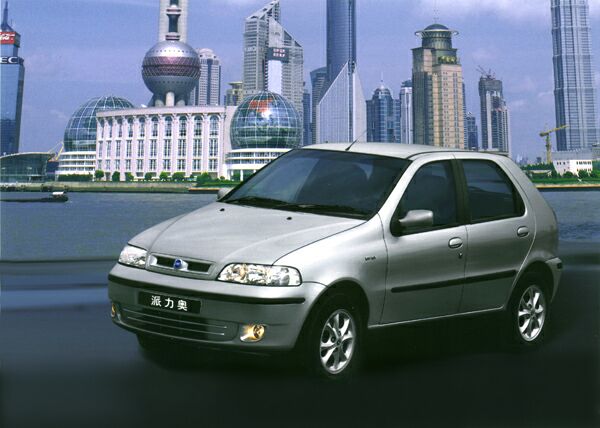
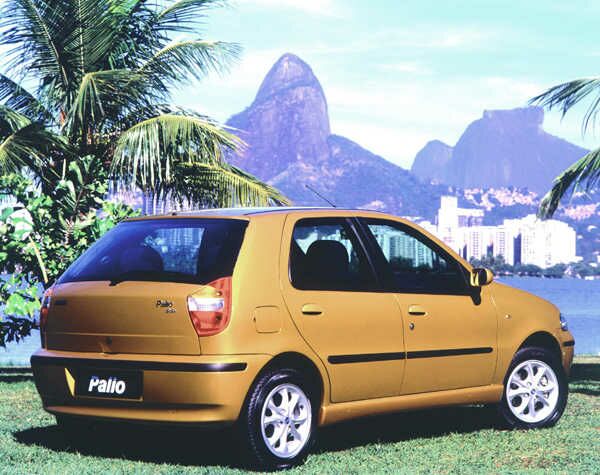
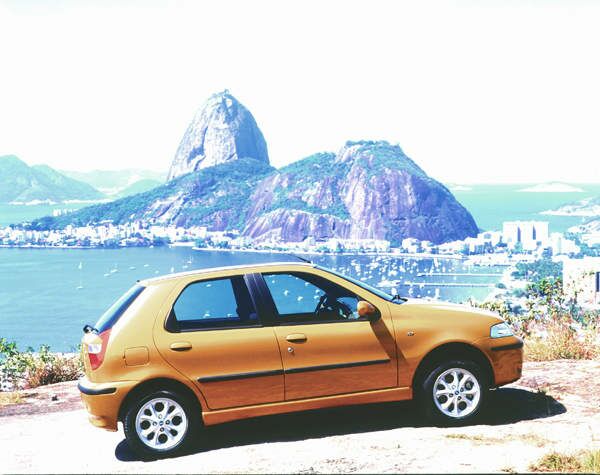
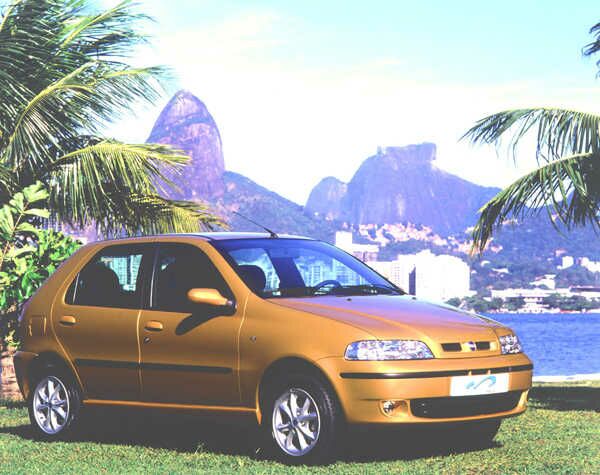
 In
the first quarter of 2002, Nanjing Fiat, the 50-50 joint venture set up
by the Fiat Group and the Yuejin Motor Group, begins to market and sell
the Fiat Palio in China. It is an important new step in the fruitful collaboration
that has linked the two companies for many years in the fields of commercial
vehicles (Iveco) and components (Teksid). The launch of the Palio today
opens up new horizons in what experts consider a rapidly expanding car
market. Suffice it to say that China's entry into the WTO and the 10th
five-year plan approved by the Chinese government envisage a significant
increase in sales in the next 3-4 years, from today's 700,000 units to
over 1.2 million cars.
In
the first quarter of 2002, Nanjing Fiat, the 50-50 joint venture set up
by the Fiat Group and the Yuejin Motor Group, begins to market and sell
the Fiat Palio in China. It is an important new step in the fruitful collaboration
that has linked the two companies for many years in the fields of commercial
vehicles (Iveco) and components (Teksid). The launch of the Palio today
opens up new horizons in what experts consider a rapidly expanding car
market. Suffice it to say that China's entry into the WTO and the 10th
five-year plan approved by the Chinese government envisage a significant
increase in sales in the next 3-4 years, from today's 700,000 units to
over 1.2 million cars.



